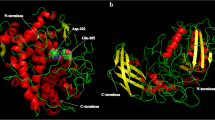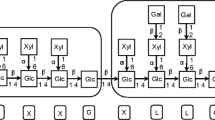Abstract
Limit dextrinase (EC 3.2.1.41) from germinating barley (Hordeum vulgare L) can be activated by millimolar concentrations of linear maltodextrins with a degree of polymerisation ≥ 2. The activation was assay-dependent; it was detected using assays based on the solubilisation of cross-linked dyed pullulan but not in assays that directly measured cleavage events such as the formation of new reducing termini. This strongly suggested that maltodextrins did not increase the catalytic rate of limit dextrinase i.e. this is not a true activation. On the other hand, considerable activation was noted in assays that measured pullulan degradation by reduction in viscosity. Taken together, this suggested that maltodextrins altered the mode of action of limit dextrinase, causing more rapid decreases in viscosity or greater solubilisation of dye-linked pullulan fragments per cleavage event. The proposed mechanism of activation by alteration in action pattern was reminiscent of initial work in the discovery of xyloglucan endotransglycosylase. Therefore, the ability of limit dextrinase to catalyse transglycosylation reactions into pullulan was tested and confirmed by an assay based on the incorporation of a fluorescently labelled maltotriose derivative into higher-molecular-weight products. The transglycosylation reaction was dependent on limit dextrinase activity and was enhanced in more highly purified preparations of limit dextrinase. Transglycosylation was inhibited by unlabelled maltotriose. How transglycosylation accounts for the apparent activation of limit dextrinase by maltodextrins and the physiological relevance of this novel reaction are discussed.







Similar content being viewed by others
Abbreviations
- APTS :
-
8-Amino-1,3,6-pyrene trisulphonic acid
- DP :
-
Degree of polymerisation
- G :
-
Glucose
- G2 :
-
Maltose
- G3–G7 :
-
Linear maltodextrins of DP 3–7, i.e. maltotriose to maltoheptaose
- G3–APTS :
-
Maltotriose APTS derivative
- LD :
-
Limit dextrinase
- PAHBAH :
-
p-Hydroxybenzoic acid hydrazide
- UPW :
-
Ultra-pure water
References
Blake, MS, Johnston KH, Russell-Jones GJ, EC Gotsclich (1984) A rapid, sensitive method for detection of alkaline phosphatase-conjugated anti-antibody on Western blots. Anal Biochem 136:175–179
Bradford MM (1976) A rapid and sensitive method for the quantitation of microgram quantities of protein utilising the principle of protein–dye binding. Anal Biochem 72:248–254
Bringhurst TA, Broadhead AL, Brosnan, JM, Pearson SY, Walker JW (2001) The identification and behaviour of branched dextrins in the production of Scotch whisky. J Inst Brew London 107:137–149
Burton RA, Zhang X-Q, Hrmova M, Fincher GB (1999) A single limit dextrinase gene is expressed both in the developing endosperm and in germinated grains of barley. Plant Physiol 199:859–871
Burton RA, Jenner H, Carrangis L, Fahy B, Fincher GB, Hylton C, Laurie DA, Parker M, Waite D, van Wegan S, Verhoeven T, K Denyer (2002) Starch granule initiation and growth are altered in barley mutants that lack isoamylase activity. Plant J 31:97–112
Cho M-J, Wong JH, Marx C, Jiang W, Lemaux PG, Buchanan BB (1999) Over-expression of thioredoxin h leads to enhanced activity of starch debranching enzyme (pullulanase) in barley grain. Proc Natl Acad Sci USA 96:14641–14646
Coutinho PM, Henrissat B (1999) Carbohydrate-active enzymes: an integrated database approach. In: Gilbert HJ, Davies G, Henrissat B, Svensson, B (eds) Recent advances in carbohydrate bioengineering. The Royal Society of Chemistry, Cambridge, pp 3–12
Dubois M, Gilles KA, Hamilton JK, Rebers PA, Smith FA (1956) Colorimetric method for determination of sugars and related substances. Anal Chem 28:350–356
Dunn G, Manners DJ (1975) The limit dextrinases from ungerminated oats (Avena sativa L.) and ungerminated rice (Orzya sativa L.). Carbohydr Res 39:283–293
Enevoldsen BS, Bathgate GN (1969) Structural analysis of wort dextrins by means of beta-amylase and the debranching enzyme, pullulanase. J Inst Brew London 75:433–443
Fry SC (1997) Novel dot blot assays for glycosyltransferases and glycosylhydrolases: optimisation for xyloglucan endotransglycosylase (XET) activity. Plant J 11:1141–1150
Fry SC, Smith RC, Renwick KF, Martin DJ, Hodge SK, Matthews KJ (1992) Xyloglucan endotransglycosylase, a new wall-loosening enzyme activity from plants. Biochem J 282:821–828
Hamilton LM, Kelly CT, Fogarty WM (2000) Review: cyclodextrins and their interaction with amylolytic enzymes. Enzyme Microbial Technol 26:561–567
Hardie DG, Manners DJ, Yellowlees D (1976) The limit dextrinase from malted sorghum (Sorghum vulgare) Carbohydr Res 50:75–85
Jespersen HM, MacGregor EA, Henrissat B, Sierks MR, Svensson B (1993) Starch- and glycogen-debranching and branching enzymes: prediction of structural features of the catalytic (β/α)8-domain and evolutionary relationship to other amylolytic enzymes. J Protein Chem 12:791–805
Kitahata S, Tanimoto T, Ikuta A, Tanaka K, Fujita K, Hashimoto H, Murakami H, Nakano H, Koizumi K (2000) Synthesis of novel heterobranched beta-cyclodextrins from 4(2)–O-beta-d-galactosyl-maltose and beta-cyclodextrin by the reverse action of pullulanase, and isolation and characterisation of the products. Biosci Biotechnol Biochem 64:1223–1229
Kristensen M, Planchot V, Abe J-I, Svensson B (1998) Large-scale purification and characterisation of barley limit dextrinase, a member of the alpha-amylase structural family. Cereal Chem 75:473–479
Kristensen M, Lok F, Planchot V, Svendson I, Leah R, Svensson B (1999) Isolation and characterisation of the gene encoding the starch debranching enzyme limit dextrinase from germinating barley. BBA 1431:538–546
Kubo A, Fujita N, Harada K, Matsuda T, Satoh H, Nakamura Y (1999) The starch debranching enzymes isoamylase and pullulanase are both involved in amylopectin biosynthesis in rice endosperm. Plant Physiol 121:399–409
Lee EY, Marshall JJ, Whelan WJ (1971) The substrate specificity of amylopectin-debranching enzymes from sweet corn. Arch Biochem Biophys 143:365–374
Lee WJ, Pyler RE (1984) Barley malt limit dextrinase: varietal, environmental and malting effect. J Am Soc Brew Chemists 42:11–17
Lever M (1972) A new reaction for colorimetric determination of carbohydrates. Anal Biochem 47:273–279
Longstaff MA, Bryce JH (1993) Development of limit dextrinase in germinated barley (Hordeum vulgare L). Evidence of proteolytic activation. Plant Physiol 101:881–889
MacGregor AW (1996) Malting and brewing science: challenges and opportunities. J Inst Brew 102:97–102
MacGregor AW, Fincher GB (1993) Carbohydrates of the barley grain. In: MacGregor AW, Bhatty RS (eds) Barley: chemistry and technology. American Association of Cereal Chemists, St. Paul, MN, pp 73–130
MacGregor AW, Macri LJ, Schroeder SW, Bazin SL (1994) Purification and characterisation of limit dextrinase inhibitors from barley. J Cereal Sci 20:33–41
MacGregor AW, Bazin SL, Macri LJ, Babb JC (1999) Modelling the contribution of alpha-amylase, beta-amylase and limit dextrinase to starch degradation during mashing. J Cereal Sci 29:161–169
MacGregor AW, Bazin SL, Schroeder SW (2002) Effect of starch hydrolysis products on the determination of limit dextrinase and limit dextrinase inhibitors in barley and malt. J Cereal Sci 35:17–28
Macri LJ, MacGregor AW, Shroeder SW, Bazin SL (1993) Detection of a limit dextrinase inhibitor in barley. J Cereal Sci 18:103–106
McCleary BV (1992) Measurement of the content of limit dextrinase in cereal flours. Carbohydr Res 227:257–268
McDougall GJ, Fry SC (1990) Xyloglucan oligosaccharides promote growth and activate cellulase: evidence for a role for cellulase in cell expansion. Plant Physiol 93:1042–1048
Merji M, Mathlouthi M (2001) Effect of small carbohydrates on the catalytic activity of a protease and two glycohydrolases. Carbohydr Polym 45:161–167
Mouille G, Maddelein ML, Libessart N, Talaga P, Decq A, Del-rue B, Ball S (1996) Preamylopectin processing: a mandatory step for starch biosynthesis in plants. Plant Cell 8:1353–1366
Morell MK, Samuel MS, O’Shea MG (1998) Analysis of starch structure using fluorophore-assisted carbohydrate electrophoresis. Electrophoresis 19:2603–2611
Nakamura Y, Kubo A, Shimamune T, Matsuda T, Harada K, Satoh H (1997) Correlation between activities of starch de-branching enzyme and alpha-polyglucan structure in endosperms of sugary-1 mutants of rice. Plant J 12:143–153
Pan D, Nelson OE (1984) A debranching enzyme deficiency in endosperm of the sugary-1 mutants of maize (Zea mays). Plant Physiol 74:324–328
Panchal CJ, Stewart GG (1979) Utilisation of wort carbohydrates. Brew Dig 54:36–43
Sissons MJ, Lance RCM, Sparrow DHB (1993) Studies on limit dextrinase in barley. 3. Limit dextrinase in developing kernels. J Cereal Sci 17:19–24
Stenholm K (1997) Malt limit dextrinase and its importance in brewing. VTT publication no 323, VTT, Technical Research Centre of Finland, Espoo, Finland
Svensson B (1994) Protein engineering in the α-amylase family: catalytic mechanism, substrate specificity, and stability. Plant Mol Biol 25:141–157
Swanston JS, Taylor K (1990) The effects of different steeping regimes on water uptake, germination rate, milling energy and hot water extract. J Inst Brew 96:3–6
Takaha T, Yanase M, Okada S, Smith SM (1993) Disproportionating enzyme (4-α-glucanotransferase; EC 2.4.1.25) of potato. Purification, molecular cloning, and potential role in starch metabolism. J Biol Chem 268:1391–1396
Takata H, Kuriki T, Okada S, Takesada Y, Iizuka M, Minamiura N, Imanaka T (1992) Action of neopullulanase. Neopullulanase catalyzes both hydrolysis and transglycosylation at the α-(1-4)- and α-(1-6)-glucosidic linkages. J Biol Chem 267:18447–18452
Acknowledgements
The Scottish Crop Research Institute acknowledges grant-in-aid from the Scottish Executive Environment and Rural Affairs Department. We are indebted to Prof. Birte Svensson for her gift of polyclonal antibodies against LD and her helpful advice. We thank Dr. Barry McCleary of Megazyme International Ireland Ltd for his enthusiasm, advice, time and kind gifts of materials; Dr. Steve Smith (University of Edinburgh) for his gift of polyclonal antibodies against D-enzyme, and for his advice; and Dr. Sandy MacGregor of the Canadian Grain Commission for helpful discussions. We thank Dr. Derek Stewart for his help; Dr. Nigel Deighton for LC–MS/MS analyses; Julie Sungurtas and Laurence Ducreux for their technical help; Tom Geoghegan for his photographic expertise; and Ian Pitkeithly for help with graphics.
Author information
Authors and Affiliations
Corresponding author
Rights and permissions
About this article
Cite this article
McDougall, G.J., Ross, H.A., Swanston, J.S. et al. Limit dextrinase from germinating barley has endotransglycosylase activity, which explains its activation by maltodextrins. Planta 218, 542–551 (2004). https://doi.org/10.1007/s00425-003-1141-1
Received:
Accepted:
Published:
Issue Date:
DOI: https://doi.org/10.1007/s00425-003-1141-1




